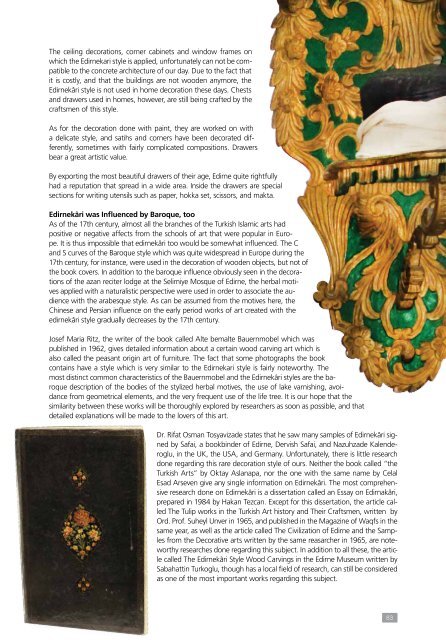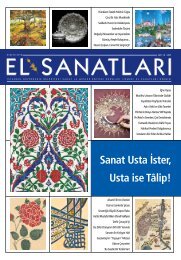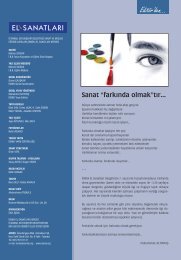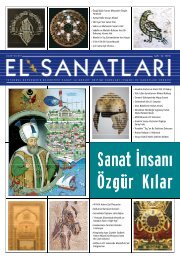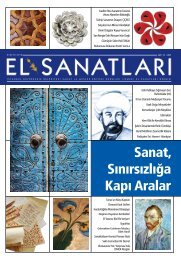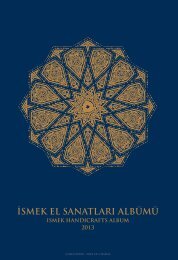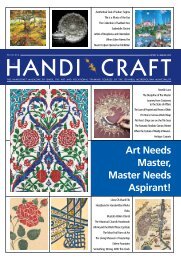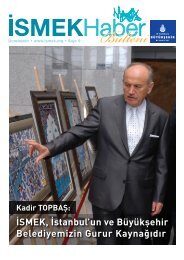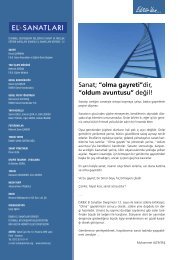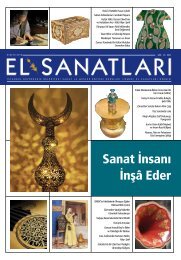Create successful ePaper yourself
Turn your PDF publications into a flip-book with our unique Google optimized e-Paper software.
The ceiling decorations, corner cabinets and window frames onwhich the Edirnekari style is applied, unfortunately can not be compatibleto the concrete architecture of our day. Due to the fact thatit is costly, and that the buildings are not wooden anymore, theEdirnekâri style is not used in home decoration these days. Chestsand drawers used in homes, however, are still being crafted by thecraftsmen of this style.As for the decoration done with paint, they are worked on witha delicate style, and satihs and corners have been decorated differently,sometimes with fairly complicated compositions. Drawersbear a great artistic value.By exporting the most beautiful drawers of their age, Edirne quite rightfullyhad a reputation that spread in a wide area. Inside the drawers are specialsections for writing utensils such as paper, hokka set, scissors, and makta.Edirnekâri was Influenced by Baroque, tooAs of the 17th century, almost all the branches of the Turkish Islamic arts hadpositive or negative affects from the schools of art that were popular in Europe.It is thus impossible that edirnekâri too would be somewhat influenced. The Cand S curves of the Baroque style which was quite widespread in Europe during the17th century, for instance, were used in the decoration of wooden objects, but not ofthe book covers. In addition to the baroque influence obviously seen in the decorationsof the azan reciter lodge at the Selimiye Mosque of Edirne, the herbal motivesapplied with a naturalistic perspective were used in order to associate the audiencewith the arabesque style. As can be assumed from the motives here, theChinese and Persian influence on the early period works of art created with theedirnekâri style gradually decreases by the 17th century.Josef Maria Ritz, the writer of the book called Alte bemalte Bauernmobel which waspublished in 1962, gives detailed information about a certain wood carving art which isalso called the peasant origin art of furniture. The fact that some photographs the bookcontains have a style which is very similar to the Edirnekari style is fairly noteworthy. Themost distinct common characteristics of the Bauernmobel and the Edirnekâri styles are the baroquedescription of the bodies of the stylized herbal motives, the use of lake varnishing, avoidancefrom geometrical elements, and the very frequent use of the life tree. It is our hope that thesimilarity between these works will be thoroughly explored by researchers as soon as possible, and thatdetailed explanations will be made to the lovers of this art.Dr. Rifat Osman Tosyavizade states that he saw many samples of Edirnekâri signedby Safai, a bookbinder of Edirne, Dervish Safai, and Nazuhzade Kalenderoglu,in the UK, the USA, and Germany. Unfortunately, there is little researchdone regarding this rare decoration style of ours. Neither the book called “theTurkish Arts” by Oktay Aslanapa, nor the one with the same name by CelalEsad Arseven give any single information on Edirnekâri. The most comprehensiveresearch done on Edirnekâri is a dissertation called an Essay on Edirnakâri,prepared in 1984 by Hakan Tezcan. Except for this dissertation, the article calledThe Tulip works in the Turkish Art history and Their Craftsmen, written byOrd. Prof. Suheyl Unver in 1965, and published in the Magazine of Waqfs in thesame year, as well as the article called The Civilization of Edirne and the Samplesfrom the Decorative arts written by the same reasarcher in 1965, are noteworthyresearches done regarding this subject. In addition to all these, the articlecalled The Edirnekâri Style Wood Carvings in the Edirne Museum written bySabahattin Turkoglu, though has a local field of research, can still be consideredas one of the most important works regarding this subject.83


